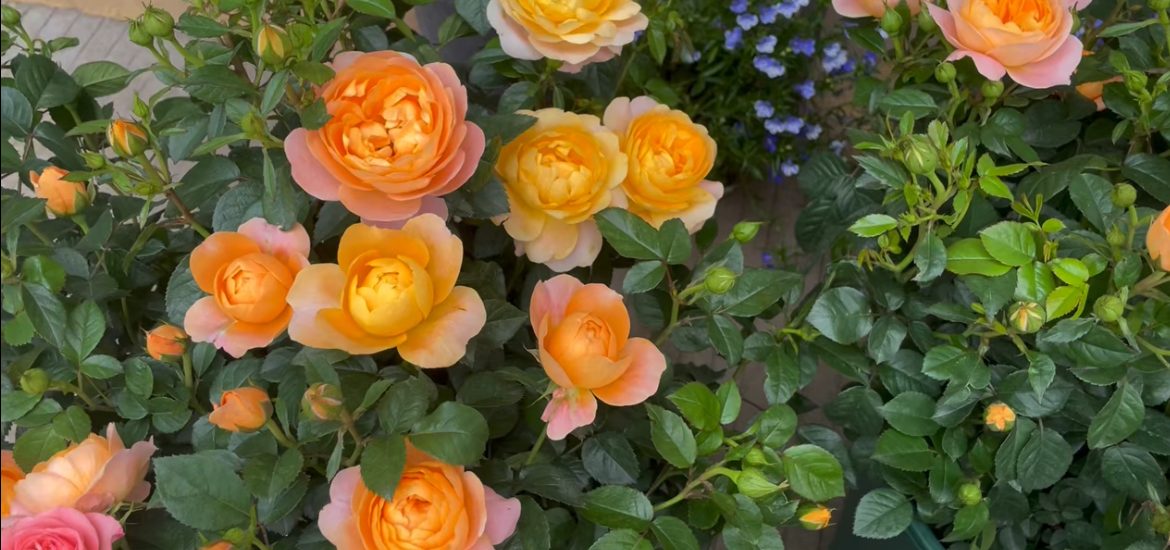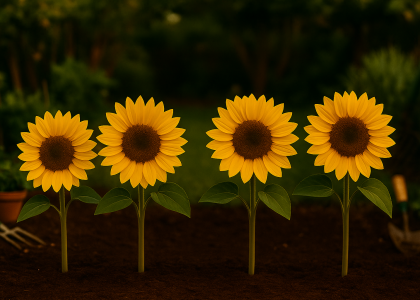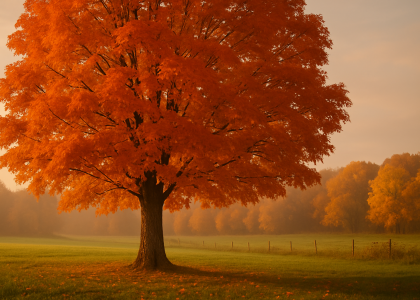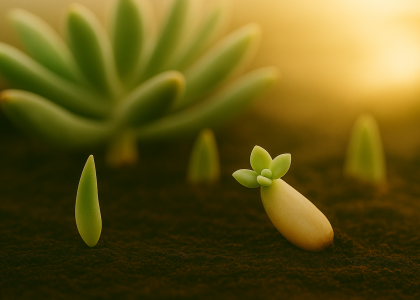More than a flower—it’s an invitation to live more beautifully.
A Flower That Dances with the Wind
Among the many varieties of roses, two often capture the hearts of gardeners: the ever-blooming Rosa chinensis, and the richly fragrant Rosa rugosa. Though they differ in habit and scent, they share the same botanical lineage—both are true members of the Rosa genus.
But today, we turn our attention to one of the most graceful and generous members of the family: the Chinese rose, or Rosa chinensis. Often called the “monthly rose” for its ability to bloom again and again through the seasons, this rose doesn’t simply bloom and disappear. It lingers. It returns. It performs.
Each morning it may offer you something new:
A tightly wrapped bud, whispering with potential.
A fully open bloom, dancing with bees and butterflies.
A serrated green leaf, catching the first light, holding a single pearl of dew.
In a fast-paced world, Rosa chinensis reminds us to slow down—to notice, to breathe, and to delight in beauty that unfolds gently, over time.
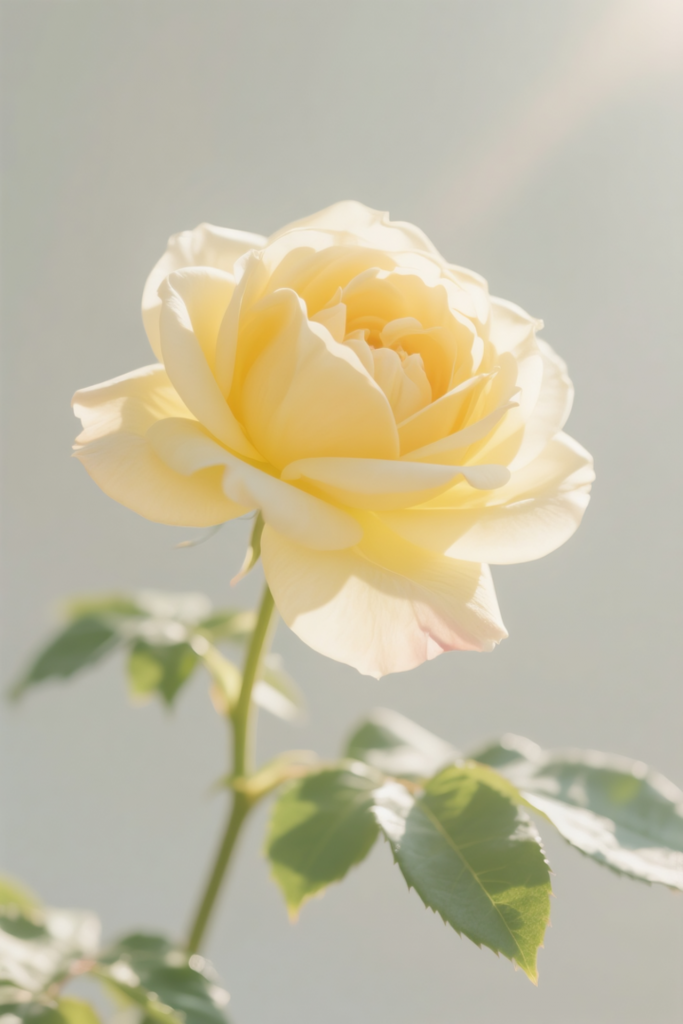
A Quick Background: Where Rosa chinensis Comes From
Rosa chinensis, widely known as the Chinese rose or monthly rose, originated in Southwest China and has been cultivated for centuries for its ornamental and herbal value. What sets it apart in rose history is its repeat-blooming nature—unlike traditional European roses that only bloom once a year, this variety can flower multiple times across the seasons.
This characteristic led to its rise as a foundational parent in breeding modern hybrid roses. It played a key role in the creation of today's garden favorites like hybrid teas and floribundas.
Recognizing Rosa chinensis
- Flowers: Medium-sized, papery petals in colors ranging from blush pink to crimson red. Some varieties fade into orange or apricot tones.
- Leaves: Glossy, dark green with finely serrated edges.
- Stems: Slender and straight, with relatively few thorns.
- Growth Habit: Upright to bushy, well-suited for both pots and landscape borders.
How to Tell Rosa chinensis from True Roses (Rosa rugosa)
Many gardeners often confuse Rosa chinensis with traditional roses, especially in floral markets where they’re commonly called the same thing. Here's how to tell them apart:
| Feature | Rosa chinensis (Chinese rose) | Rosa rugosa (True rose) |
| Bloom Cycle | Repeats all season (monthly) | One strong bloom per year |
| Petals | Thin, papery, rose-like | Thicker, slightly wrinkled petals |
| Fragrance | Light or mild scent | Rich, strong fragrance |
| Stems | Slender, fewer thorns | Thick, with many sharp thorns |
| Leaves | Glossy, finely serrated | Coarser, deeply veined |
Recognizing these traits will help you choose the right rose for your garden or craft project.
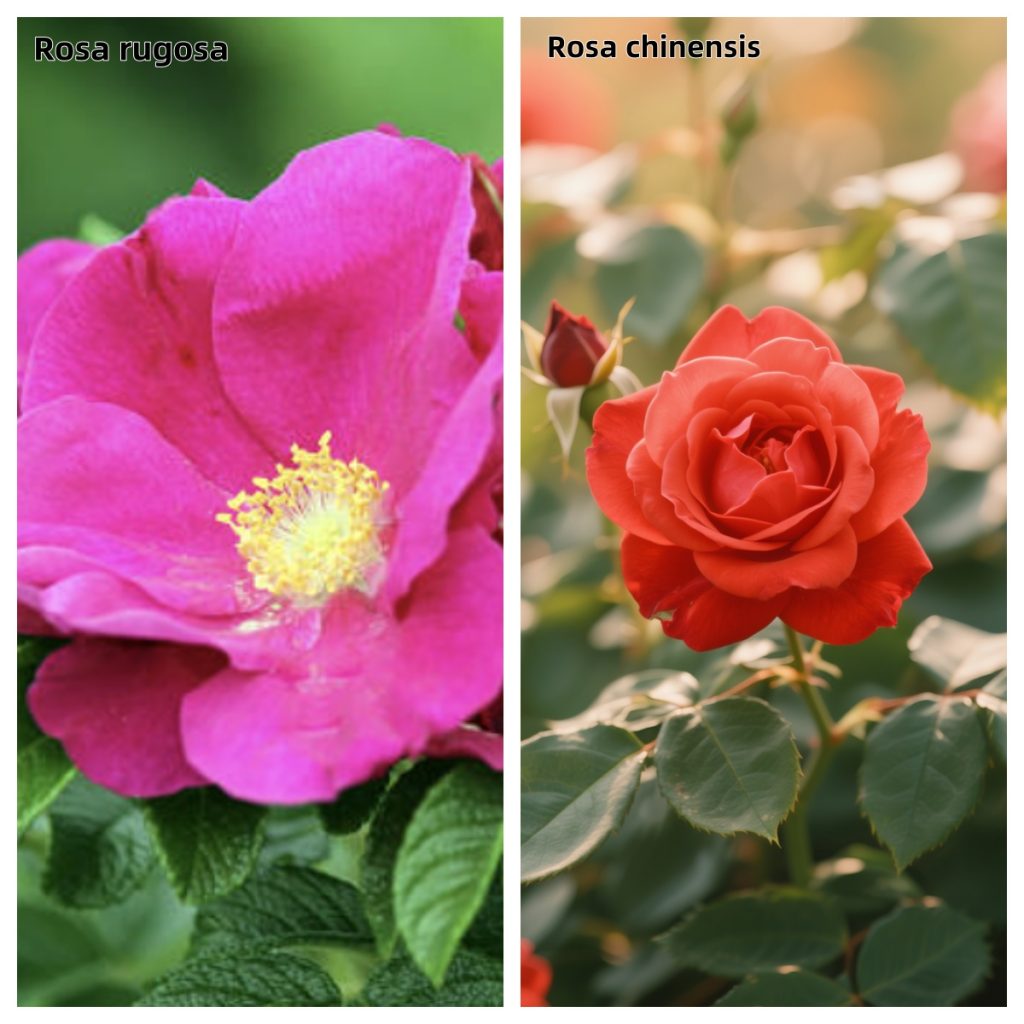
Not Just Pretty—It’s Exceptionally Practical
Medicinal & Edible Uses
- Petals can be dried for calming herbal teas, often used to reduce inflammation or support digestion.
- Rose water distilled from its blooms is a natural skincare staple.
- Rose oil can be extracted at home for aromatherapy or DIY skincare use.
- In Traditional Chinese Medicine, it is believed to “move qi,” soothe the liver, and lift the mood.
Ornamental & Emotional Value
- Excellent for cut flower arrangements due to straight stems and prolonged freshness.
- The scent attracts pollinators and brings life into garden spaces.
- Emotionally grounding—its scent, seasonal cycle, and presence nurture calm.
- Safe for kids and pets (when untreated), making it a wonderful family garden flower.
How to Grow and Care for Rosa chinensis (Chinese Rose)
| Element | Ideal Setup |
| Light | Full Sun (6–8 hours per day) |
| Soil | Well-drained loamy soil; pH 6.0–6.5 |
| Water | Deep water 2–3x/week; avoid soggy roots |
| Climate | Hardy in USDA Zones 6–10 |
| Fertilizer | Organic rose food (e.g., Espoma Rose-tone) every 3–4 weeks |
Care Tip Quick List:
- Mulch to retain moisture and regulate temperature.
- Prune in early spring; remove dead/diseased branches.
- Allow space for airflow to prevent disease.
- Deadhead regularly for continuous blooms.
- Monitor for pests and treat with neem oil or insecticidal soap.
- Pro Tip: Apply seaweed extract during the early bloom phase for bigger, longer-lasting flowers.
Common Pests & Disease Prevention
- Black Spot: Improve airflow, avoid overhead watering. Use sulfur or neem oil weekly if needed.
- Powdery Mildew: Remove infected leaves. Spray mix of 1 tsp baking soda + 1 qt water.
- Aphids: Rinse off with water or apply insecticidal soap. Encourage ladybugs!
- Garden Hack: Soak banana peel in water overnight—sprinkle on soil to deter aphids naturally.
Propagation: Multiply the Beauty
Rosa chinensis is surprisingly easy to propagate—perfect for gardeners who love sharing plants.
Cuttings
- Cut a 6-inch semi-hardwood stem in early summer.
- Dip in rooting hormone and plant in moist, sandy soil.
- Place in bright, indirect light. Roots form in ~4 weeks.
Layering
- Bend a healthy stem to touch the soil.
- Bury one node under soil while keeping the tip exposed.
- Once rooted, snip and transplant in autumn.
What Makes Rosa chinensis Unique?
- Ever-blooming: It blooms again and again from spring through fall.
- Space-saving: Perfect for balcony pots, entryway containers, or small garden beds.
- Naturally resilient: With proper care, it's both hardy and forgiving.
And of course—those elegant stems, slender and strong, paired with serrated leaves that shimmer with morning dew like lace.
Varieties Worth Growing
| Variety Name | Flower Color | Growth Habit | Highlights |
| 'Old Blush' | Soft pink | Upright & bushy | Reliable rebloomer, light fragrance |
| 'Mutabilis' | Apricot-pink | Tall & airy | Changes color as it ages |
| 'Cramoisi Supérieur' | Deep red | Compact shrub | Velvety texture, rich scent |
| Miniature Hybrids | Mixed shades | Dwarf & tidy | Ideal for balconies & urban gardening |
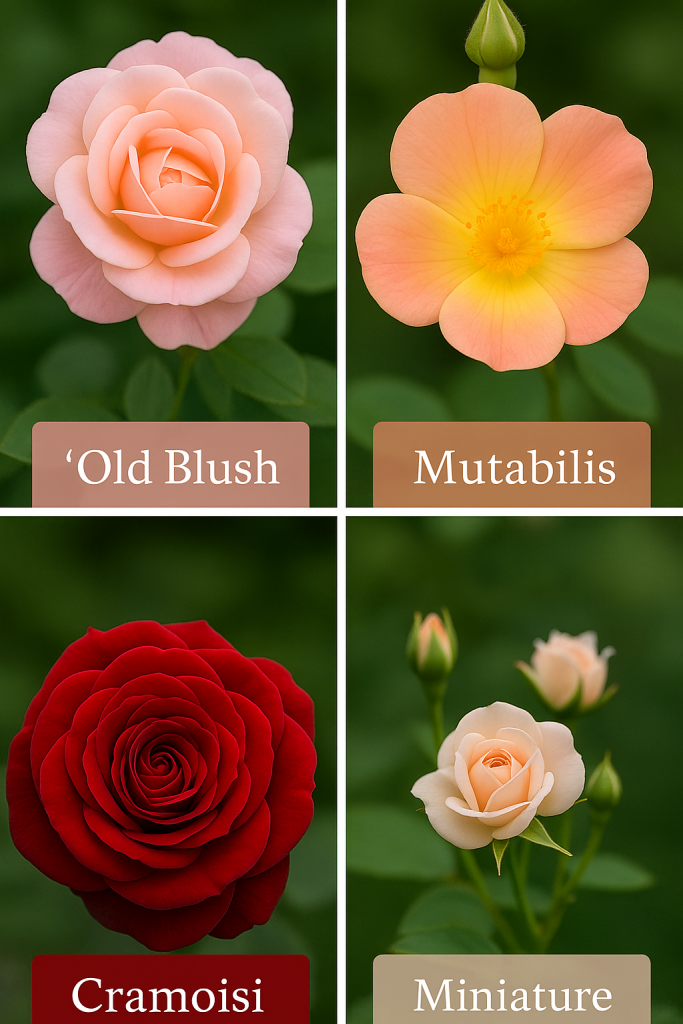
Everyday Joy: Creative Ways to Use Rosa chinensis
- Mother’s Day DIY Bouquet: Cut 5–7 stems, wrap with kraft paper & string.
- Rose Tea: Dry petals and steep in hot water with honey.
- Rose Oil Infusion: Soak petals in jojoba oil in a sunny window for 7–10 days.
- Petal Bath Soak: Add dried petals + Epsom salt for a calming soak.
- Pressed Flower Keepsake: Place in journals or bookmarks.
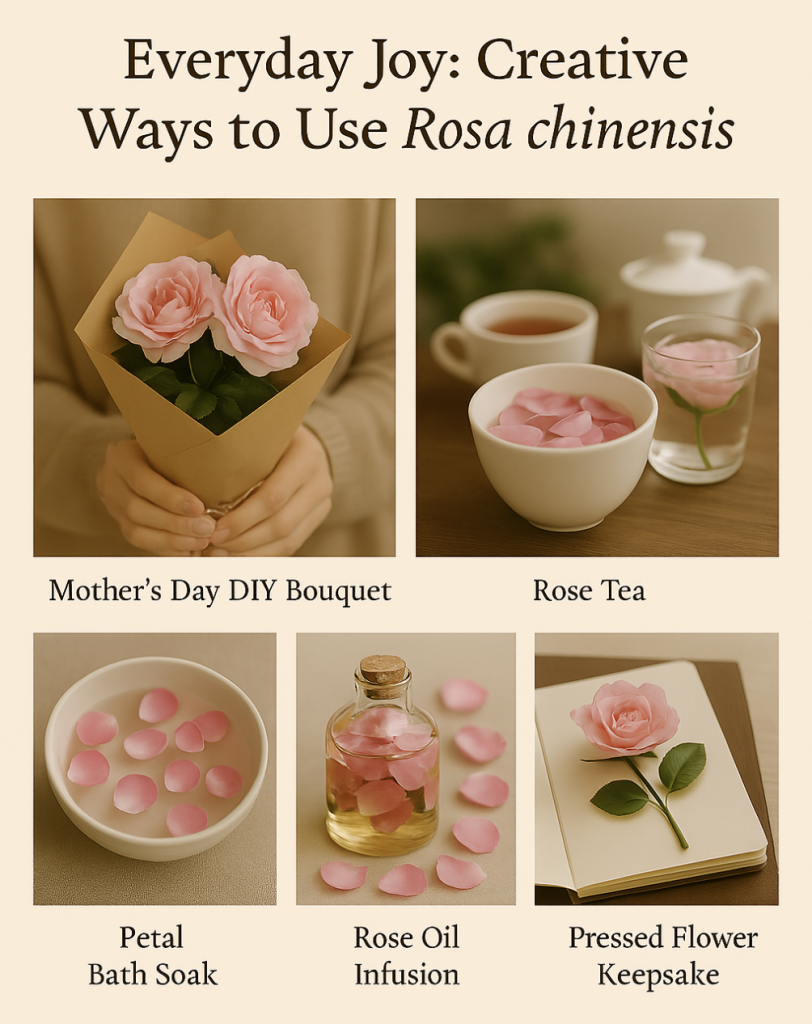
FAQ: Rosa chinensis Care & Lifestyle
Q: My rose has yellowing leaves—what’s wrong?
A: Likely overwatering or compacted soil. Check drainage and cut back on watering.
Q: Can I grow Rosa chinensis indoors?
A: Dwarf varieties can thrive near sunny windows. Full-size types prefer the outdoors.
Q: Is it safe around pets or children?
A: Yes—when untreated with chemicals, it's a gentle plant for homes with kids and pets.
Q: How do I make rose oil at home?
A: Combine dried petals with carrier oil (jojoba/sweet almond) in a jar. Let infuse 7–10 days in light. Strain before use.
Q: What’s the easiest way to start growing one?
A: Buy a small starter plant in spring, place it in a sunny container, and water deeply twice per week.
Final Words: A Plant, A Practice, A Presence
To grow Rosa chinensis is to invite gentleness into your daily life.
From the anticipation of new buds to the soft sigh of petals unfurling, every stage of this flower's life is a quiet invitation: slow down, look closer, and live with intention.
Whether you're planting your first flower or your fiftieth, Rosa chinensis will reward your care with endless color and quiet grace.

